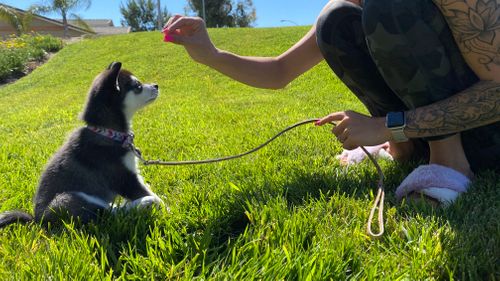Training can be one of the most rewarding exercises you do with your dog. It feels so good when the light goes on, it finally clicks, and they complete the trick or movement you’re asking them to do. On the other hand, it can be intensely frustrating when your dog is being stubborn. Today we’re going to talk about seven different tips to use when training a stubborn dog. Let’s get started!
Be consistent. Sometimes it’s not that your dog is stubborn, it’s that they are confused. Different people in their lives might be rewarding them for behaviors that you are trying to get them to stop doing. They have no way of knowing what’s right or wrong, because they’re getting mixed messages from their humans. It’s essential that anyone coming into contact with your dog knows the verbiage you use and the commands you have in place, including hand signals, when interacting with your dog, so that they don’t confuse them. This can happen very easily, too: say you’re trying to break your dog from jumping up on people, but your kids let him jump up on them when they come in the door. That’s sending a mixed message to your dog. Consistency is absolutely necessary for successful training.
Go slowly. Start off initially by working with your dog on familiar behaviors. Create a positive association in training by rewarding even small successes. Linking a treat to a small success teaches the dog that training itself is a good thing. And change only one variable at a time: if your dog has learned to sit, then, teach them to sit with another person in the room or the television on. If you introduce too many variables into the training environment at once, your dog is likely to give up.
Make it a habit. Training shouldn’t be a once-per-day kind of thing, but more of a several-short-sessions-per-day thing. The more it’s a part of your routine, the more your dog knows that it’s what is expected of her regularly. It can be as simple as asking your dog to sit or lie down and following the successful completion with a treat. The more you do it habitually, the more she’s going to understand that you expect it of her regularly.
Control the environment. During training sessions, make sure it’s easy for your dog to stay focused. Find a distraction-free area, such as your living room or kitchen. Put toys away that may tempt him towards distraction. And if you’re outside, ensure they are on a leash or a longline, or inside a well-fenced area. The most well-behaved animal in the world is often no match for the temptation of a squirrel or a cat or the like.
Choose good rewards. Just like humans, animals have preferences in terms of their rewards. Some dogs are highly food- or treat-motivated and some couldn’t care less and would much rather play or go for a walk. Spend some time searching out what your dog really loves, and then use that to reward them for good behavior. Tossing them treats doesn’t mean anything if they’re not into them, and giving pets and play won’t matter as much to treat-oriented animals. Some things you can use as rewards are play (especially with a specific toy or type of toy), walks, petting, or praising.
Avoid punishment. Punishment does a dog in training no good. It increases their anxiety and undermines their trust in you, and in the long term, it can lead to a heightened risk of aggression. Instead of punishing bad behavior, reward good behavior, using a reward that is meaningful to your dog. When they display bad behavior, lead them to good behavior, and then praise them and reward them for completing it. Punishment doesn’t work because dogs don’t understand it. It makes no sense to them.
Seek help. If your dog isn’t showing signs of improvement or if they are aggressive or fearful, find a good obedience school in your area. There are hundreds of thousands of experts out there who would love the chance to work with your dog. And experts know best how to handle dogs: it’s literally what they do for a living!
There are an abundance of schools that would be happy to work with you and your new Alaskan Klee Kai puppy in terms of training and obedience. You can look for one in your area easily online. Have fun with training!

